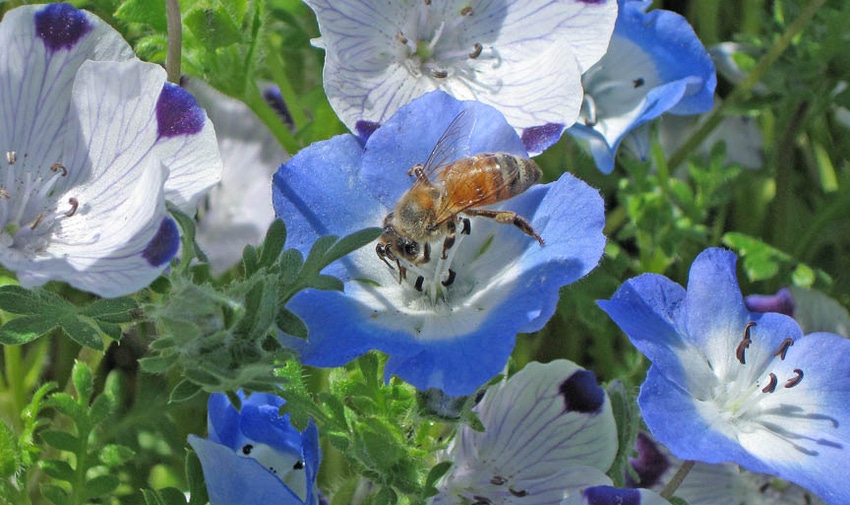September 24, 2013

Almonds are referenced in virtually every news report about bees. The overall tone of media references to the almond industry as it relates to bee health decline is neutral, but the sheer size and reliance on pollination of the almond industry is driving interest in the subject.
Further, recent news articles in publications such as Time magazine, largely reference the Report on the National Stakeholders Conference on Honey Bee Health held in Oct. 2012. In short, that report separated the issues impacting the overall health of bees into four main categories: 1) nutrition, 2) pesticides, 3) parasites/pathogens and 4) genetics/ biology/ breeding.
Investment in Honey Bee Health
As a matter of fact, the Almond Board has invested nearly $1.3 million in honey bee health research since 1995 in these four areas. During the last several years, the primary focus of this research has been healthy hives, which includes improving honey bee nutrition, effective management of bee pests and diseases, improving honey bee breeding stock, and assessing impacts of pesticides used on almonds. The Almond Board of California, in collaboration with Project Apis m., USDA, the University of California, beekeeper organizations and other groups, has and is supporting research and has developed best management practices in these categories for growers and beekeepers alike.
Among recently and currently funded research projects and collaboration:
• Improving genetic diversity in honey bees to enhance resistance to pests and diseases, and transferring that technology to bee breeders for integration into commercial breeding stock.
• Cooperating with Project Apis m. and others to encourage almond growers to provide blooming plants or “bee pasture” adjacent to almond acreage as overwintering food sources for honey bees prior to almond bloom. This promotes the health and survival of overwintering bees and thereby improves pollination.
• Participating in a USDA grant advancing “Integrated Crop Pollination.” This approach integrates honey bees, other managed pollinators like the blue orchard bee, and “bee pasture” for almond pollination.
• Development of a new online learning program through the UC Cooperative Extension to provide growers, beekeepers and apiary inspectors easily accessible, standardized information about honey bee biology, recommended colony strength evaluation practices and important honey bee diseases, pests and parasites. The online program can be accessed through the University of California ANR Online Learning website at http://ucanr.edu/colonystrength.
• Developing tools to control Varroa mites and other bee pests
• Understanding the potential impact of pesticides used in almonds on honey bee development
• Developing in-hive supplemental diets for bees, which are used when natural pollen sources are at a low ebb
• Supporting outreach or “technology transfer teams” that have implemented diagnostic and integrated pest management (IPM) programs for beekeeping operations resulting in better control of beehive pests with fewer chemicals.
Pollination service is the second-largest expense for almond growers, with pricing currently running about $150 per hive, depending on market conditions. The number of commercially kept hives has stayed fairly stable for almost two decades; however, there are increased overwintering losses and beekeepers spend more money to rebuild apiaries and ensure there are enough bees for almond pollination. Overwintering hive losses, which have averaged 30 percent over the last seven years (compared to about 15 percent previously), have a direct impact on the cost of hives to almond growers.
Bee Best Management Practices
It is important that growers of all crops who rely on the honey bee to pollinate their crop implement best management practices to support bee health and begin discussing the efforts they take to promote and protect honey bee health.
Each year the Almond Board uses the latest research to update our Best Management Practices for almond disease protection and insect control during bloom. The health of the honey bee is a top priority in the Best Management Practices. It isn’t too early to begin thinking about our Pollination BMPs, which include:
• Avoid applications of insecticides during bloom;
• Minimize exposure of honey bees to any spray by avoiding applications when pollen is available and bees are foraging;
For a more detailed list, please contact the Almond Board of California or visit AlmondBoard.com/Growers, and under orchard management, choose pollination, then Bee Protection.
From food safety to sustainability and now to pollination — the almond industry has a very long history of directly addressing issues as they enter into the public realm. The Almond Board will continue to support the efforts of individual growers, beekeepers and other stakeholders as they manage pollinator health issues to not only ensure the future of a healthy almond industry — but also a healthy relationship between stakeholders and the almond-buying community.
Almond growers and all growers who rely on domestic honeybees to pollinate their crops share responsibility for communicating what is being done to protect honeybee health.
More from Western Farm Press
GMO website developed to combat misinformation
You May Also Like




